
Mosquitoes can be a nuisance, especially the species that pose a public health risk. Below are some of the common questions we receive from our clients at UF/IFAS Extension Sarasota County and Sarasota County’s Mosquito Management Services.
Why do we manage mosquitoes?
As mentioned above, some mosquitoes pose a public health risk. These are species that are known vectors of disease-causing pathogens. In Florida, there are quite a few species of mosquitoes that are of human and animal health concern. Below are four notable species, due to their association with disease.
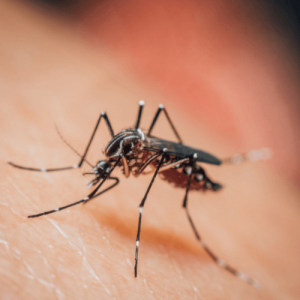
Vector of dengue, chikungunya, and Zika viruses
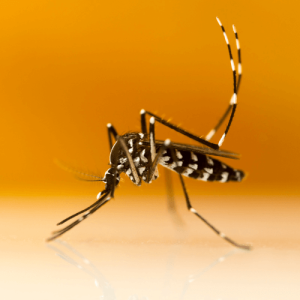
Vector of dengue, chikungunya, and Zika viruses
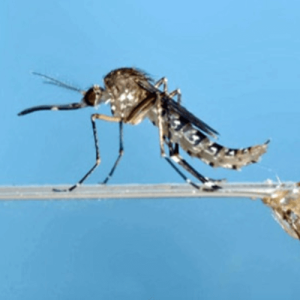
Vector of dog heartworm (Credit: James M. Newman, University of Florida)

Vector of dog heartworm, St. Louis encephalitis virus, West Nile virus
Managing these mosquitoes effectively is extremely important for protecting the health of humans, pets, and livestock. You can read more about the diseases themselves by visiting this page.
Click here to see weekly reports of arboviruses from the Florida Department of Health.
When are mosquitoes most common?
Mosquitoes require water to reproduce, as their larvae and pupae are entirely aquatic. So, it would naturally make sense for them to be more active after a rainstorm. When it rains, water fills cavities and open containers in the landscape. Female mosquitoes take flight for a bloodmeal before laying their eggs in areas with a sufficient amount of still water. For many mosquito species, it takes about a week of development time to go from egg to adult.

Sarasota County’s rainy season runs from June 1 to September 30. These four months are when we receive the majority of our annual rainfall. Although you’ll find mosquitoes throughout the year, their populations tend to be much higher during this time. Some ways you can prepare for rainy season include repairing or replacing ripped screens, purchasing a battery-powered fan, stocking up on EPA-registered repellants, and signing up for alerts from Mosquito Management Services.
How do I know it’s a mosquito?
Believe it or not, mosquitoes are actually a type of fly! They have a piercing-sucking proboscis, long, thin legs, scales on their body, and one set of true wings, unlike most insects.
Mosquito
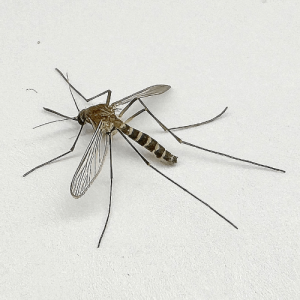
Mosquitoes have several lookalikes that may cause confusion for the average person. These lookalikes are not known to cause disease in Florida, and only one is known to bite. Learn more about these lookalikes below.
Midges
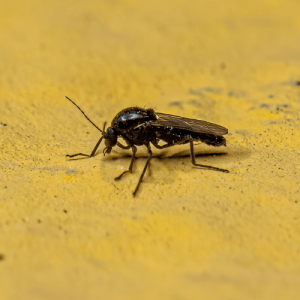

There are two main types of midges: biting and non-biting. Like the mosquito, both require water for part of their life cycle. Biting midges are also commonly called “noseeums,” due to their very tiny size. Adults are often no longer than 1/8 inch. Their bites are often small, numerous, and painful, with welts lasting days to weeks (for some unfortunate individuals).
Non-biting midges do not bite but occasionally can be a nuisance due to their sheer numbers. It is recommended to make peace with these creatures, given their significant role in the food chain for both fish and birds. However, if you find that they are becoming bothersome, you can work with your community to implement an integrated pest management (IPM) plan.
Craneflies
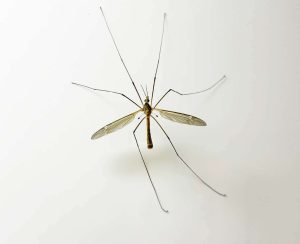
Sometimes called “mosquito hunters,” craneflies are short-lived and often do not eat at all in their adult form! If they do, they are only able to consume liquids due to their straw-like mouthparts (if present). There are reportedly some cranefly larvae that feed on mosquitoes, but it is not a common behavior. Given their short time on Earth, the best form of control is to wait until they’re gone.
Fungus gnats

Dark-winged fungus gnats are common plant pests that are easy to control. Sometimes they can be cause for alarm when they swarm in large numbers. Simply allow house plants to dry out between waterings to disrupt the gnat’s life cycle.
How do I keep pollinators safe?
If used inappropriately, many pesticides used to treat adult mosquitoes are dangerous to pollinators and other beneficial insects. To minimize impacts, the focus should always be on treating larvae first. This can be done through managing breeding habitat and applying a bacterial insecticide, known as Bti, to areas that can’t easily be managed. Natural predators, such as mosquitofish, also help reduce larval populations in an environmentally sustainable way.
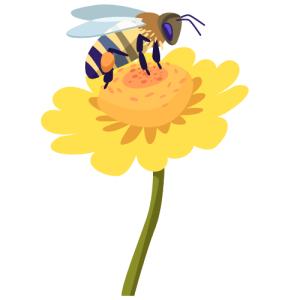 When adulticides are used, it should be according to the label and outside of active foraging times. Most pollinators actively forage for nectar from 8 am to 5 pm. Evening treatments are preferable, but early morning treatments are appropriate if the pesticide has little to no residue.
When adulticides are used, it should be according to the label and outside of active foraging times. Most pollinators actively forage for nectar from 8 am to 5 pm. Evening treatments are preferable, but early morning treatments are appropriate if the pesticide has little to no residue.
If you keep hives in Florida, you are required to register as a beekeeper through the Florida Department of Agriculture and Consumer Services (FDACS). By registering, you ensure that you are not harboring destructive honey bee diseases or pests, and you are not in possession of unwanted honey bee types.
You can maintain the safety and health of your hives by following these tips from FDACS:
- Be aware of lawn and garden and household pest control company practices on your property. Ask if they are using products that are toxic to bees, and inform them that you have hives.
- Be informed about your mosquito control district. Report your hive locations and stay up to date with mosquito spray schedules.
- Follow the recommended Best Management Practices for using in-hive pesticides.
- Be aware of nearby agricultural operations and inform them about your hives.
- Make sure your bees have adequate food and water on the property.
- Plant pollinator-friendly plants, those that produce nectar or pollen and/or are native to your region.
- Join a local beekeeping organization, native plant society or other similar group that helps spread awareness about the importance of bees.
Where can I get mosquitofish?
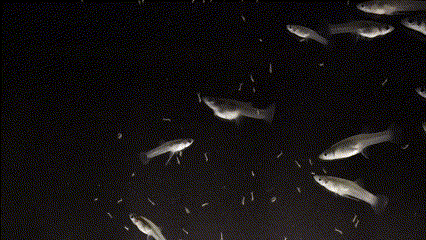
Mosquitoes have natural predators in all stages of their life, but adult mosquitoes don’t make a significant portion of any animal’s diet. Instead, the most effective predators target immature, larval mosquitoes in the water. Sarasota County’s Mosquito Management Services use native eastern mosquitofish (Gambusia holbrooki) to help combat mosquito populations. They can eat up to 100 larva or pupa per day!
Mosquitofish are great for large containers such as rain barrels, ornamental ponds, ditches, and more. Sarasota County’s Mosquito Management Services provides mosquitofish to eligible properties for free! If you reside outside the county, check with your local county or district office to see what resources may be available to you. You can see a list of mosquito control groups by visiting this website.
Sarasota County residents can request mosquitofish by filling out this application.
Which products are the most effective?
There are many products available on the market that claim to eliminate mosquitoes. It’s important to be aware of the accuracy of these claims and know where to best spend your money. Some common mosquito control “solutions” available to homeowners can be seen in the table below.

The best course of action is to follow the management tips below and report unusual amounts of mosquito activity to your local mosquito services.
What is the best way to manage mosquitoes?
Managing mosquito-borne diseases is a daily effort. Local mosquito management operations work hard to reduce mosquito populations with the environment and sustainability in mind. However, they can’t do it alone! There are many ways you can aid the effort in keeping these deadly diseases at bay.
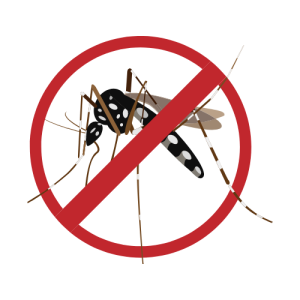 Follow these tips to reduce breeding mosquitoes around your home:
Follow these tips to reduce breeding mosquitoes around your home:
- Dump or drain any standing water. It only takes a bottle cap’s worth of water to provide a breeding ground for mosquitoes!
- Cover your outdoor garbage bins.
- Monitor mosquito larvae regularly. You can use a turkey baster to draw up water from bromeliads, bird baths, fountains, and other water features in your landscape.
- When mosquito larvae are present, use Bacillus thuringiensis var. israelensis (Bti) to treat the area. Bti is a bacterial insecticide that acts as a biocontrol, specifically targeting mosquitoes and other related, pestiferous flies. It is often available in the form of “bits” and “dunks.” Regular applications are necessary to keep populations in check.
- When possible, use aerators to keep water moving. This will make it much less likely for mosquitoes to establish.
- Contact your local mosquito management services to see if you are eligible for free mosquitofish.
- Install a fine filter on your rain barrel to prevent adult mosquitoes from laying eggs.
- Wear light-colored, loose-fitting clothing to provide a barrier to mosquitoes and other blood-sucking insects.
- Use EPA-registered mosquito repellants to keep yourself safe and itch-free.
- When possible, avoid peak mosquito hours at dusk and dawn.
Resources
The following resources were used to help develop this blog and may provide you with additional information on the subject.
- UF/IFAS Extension: Mosquitoes and their Control: Integrated Pest Management for Mosquito Reduction around Homes and Neighborhoods
- Sarasota County Mosquito Management Services
- FDOH: Mosquito-Borne and Other Insect-Borne Diseases
 6
6
